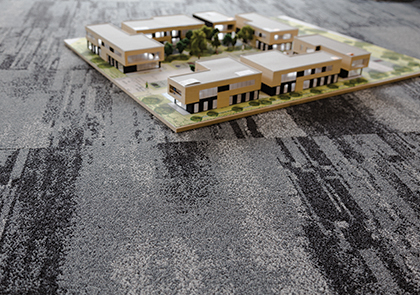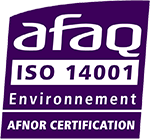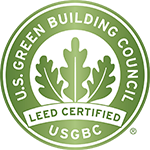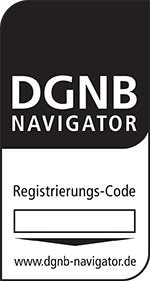
ISO certification: 14001
With this certification, we can exert greater control over the environmental side of our company’s operations. It also provides a management tool, used to integrate these issues into the company’s functions and organisation. It puts them at the same level as quality and safety. It requires the company to function differently, complying with environmental regulations and, in this way, ensuring greater financial control over the issue. BALSAN is implementing internal measures by means of an Environmental Management System (E.M.S.) involving all of the employees in the company. The international ISO 14001 standard defines the requirements specific to the implementation of an Environmental Management System within organisations of any size and in any field.
Environmental contributions
Environmental Product Declarations (EPDs) have been set up in collaboration with the GUT (Gemeinschaft Umweltfreuflicher Teppichboden). These EPDs include a product life cycle analysis, and also a range of other information required for additional environmental qualification (comfort, acoustics, VOCs). They are approved by a well reputed third party, the IBU (Institu Bauen und Umwelt).
Currently, lots of products are covered by the EPD label.
Find our entire product catalogue at the BALSAN website: https://www.balsan.com/
The GUT eco-label
Balsan carpets are accredited by the German GUT certification (European association for environmentally-friendly carpet production). This is awarded to carpets and rugs which have been manufactured responsibly in terms of the environment, safety and comfort, throughout the product’s life cycle.
Over the years, the GUT label has become a guarantee of quality. It is now recognised by the Leed® system (from version 4 onwards) regarding indoor air quality requirements. The GUT licence is awarded exclusively to manufacturers whose products meet the following criteria:
• No harmful substances
• Odour-free
• A Volatile Organic Compound (VOC) emission rate lower than 250µg/m3 over 3 days
• Extremely safe to use
HQE
Created by the HQE® association and recognised as a public utility by the decree from the 5th of January 2004, the HQE® procedure has two objectives: improving health and comfort of the users in a building and reducing its impact on the environment It concerns tertiary buildings (offices, public buildings, etc.) and defines the environmental quality of a building. There are 14 targets, split into four main sections: eco-construction, eco-management, comfort and safety.
BALSAN provides a range of broadloom and tile carpets which meet 8 out of the 14 targets included in the procedure.
BREEAM
This is an environmental building evaluation system which has been created by the BRE (Building Research Establishment). The BREEAM (BRE Environmental Assessment Method) provides a comprehensive evaluation of the environmental performance of buildings, from design to construction to use.
Concerning the evaluation of the materials used, a specific approach has been outlined. It uses audits on production sites in order to accurately establish the environmental profiles of the products according to a life cycle analysis.
LEED
LEED® (Leadership in Energy and Environmental Design) environmental evaluations provide a system to evaluate the environmental impact of buildings. It was drafted by the US Green Building Council (USBGC).
In the same way as the other systems, the LEED® approach evaluates building performance according to the following categories:
• Environmentally responsible site design and layout,
• Efficient water management,
• Energy and atmosphere,
• Materials and resources,
• Quality of the indoor environment.
The LEED® certification system only applies to buildings. This is in no way a product certification.
DgnB
DNGB® certification (Deutsches Gütesiegel für Nachhaltiges Bauen) is the German environmental evaluation system for buildings. When it was published, it only concerned administrative buildings. Since then, the scope of the certification has been extended to industrial buildings, shops, schools, hotels and more.
The primary objectives of this certification are to:
• Reduce the environmental impacts of buildings and construction sites.
• Provide added value to construction projects, especially in terms of user comfort, construction costs and building quality.
• Offer a number of elements used to classify and compare different buildings.
• Take into consideration the building’s life cycle.
The evaluation criteria can be broken down into 6 main groups:
• Environmental quality
• Economic quality
• Social and cultural quality
• Technical quality
• Process quality
• Site quality
BVB
BVB certification (short for Byggvarubedömningen) rates the quality of materials used in the construction process. The certification offers an assessment across 7 areas:
- chemical products used during the making of the product
- Assessment of raw materials
- Assessment of the construction phase
- Assessment of the management phase
- Assessment of the destruction process of the product
- Assessment of the residues and waste from the production
- Assessment of the product in the indoor environment
A final score is then given, with the grades : "recommended", "satisfactory" or "not recommended".
EPD
The EPD (Environmental Product Declaration) represents certification that a product has been shown to respect the environment throughout its production cycle. The EPD label is not limited to just building products ; it can also be applied to agricultural products, food and transport. In order to obtain EPD certification, a completely transparent technical specification of the product’s manufacturing process must be available.
M1
The M1 certification, which specialises in classifying emissions from construction materials, aims to promote the use of materials which respect indoor air quality. Its aim is that materials used in construction will not necessitate increased use of ventilation systems. The measurements are created by an independent laboratory, based on ISO 16000 standards.
Green Spirit Brochure










